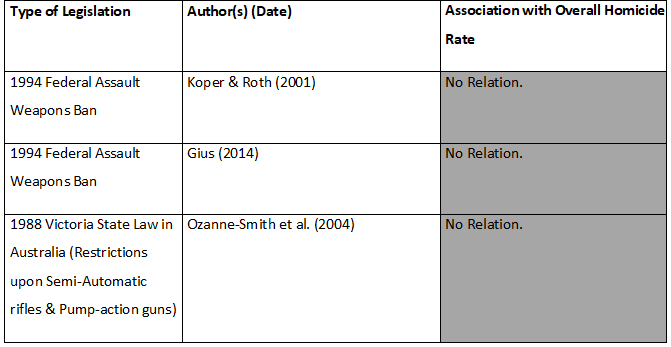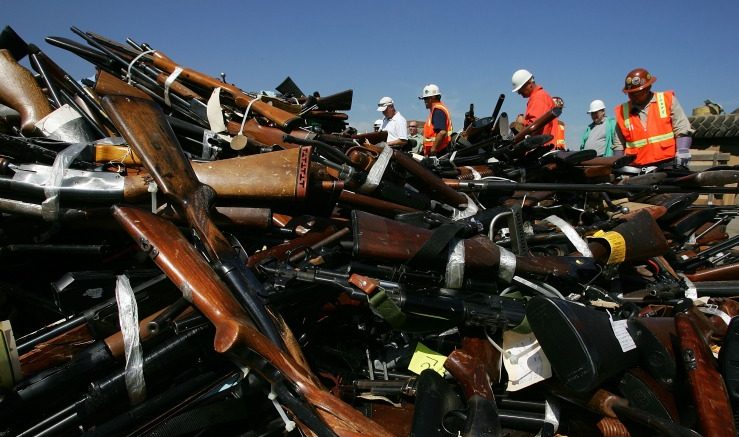Continuous (social) media coverage of the perceived higher mass shootings rate in the U.S. compared to European nations persists after each mass shooting in the country. In addition, general controversy exists surrounding the claims that U.S. gun ownership is the primary factor driving their high homicide rate, as well as claims that “common-sense gun legislation” is an effective way to mitigate this high homicide rate. In an attempt to clear the confusion and misinformation often arising in oft-heated discussions of this topic, I have analyzed all papers mentioned in the meta-analysis conducted by Santaella-Tenorio et al. (2016). People online engaged in debate are often curious about extensive volumes research on the effectiveness of firearm legislation and suspicion often exists of possibly biased and/or cherry-picked articles on this topic by critics of their position. In such scenarios, a quick reference to meta-analysis could often be beneficial.
Their review of the current state of research concerning the effectiveness of firearm legislation on a variety of social factors is condensed by me into easy-to-read tables in order to offer readers a quick way to access the current consensus on academic literature with respect to any particular form of gun legislation. I have excluded all papers solely analyzing the association of firearm legislation with suicide rates, considering that general controversy is mainly focused on the perceived relation between gun-ownership and homicide rates. For similar reasons, I have excluded research purely focusing on the rate of firearm homicides without mentioning the overall homicide rate. Any reasonable definition of effective gun legislation should not be focused on merely shifting the means of homicide from firearms to alternative weapons. On the contrary, if the high gun-ownership rate—or the lack of regulation of firearms—is related to its high overall homicide rate, then it logically follows that effective firearm legislation would be negatively related with this homicide rate.
Part 1: Right-to-Carry & Stand Your Ground Laws
Part 2: Background Checks & Mandatory Waiting Times
Contemporary proponents of more stringent gun-control legislation are especially active after every newsworthy mass-shooting and school-shooting in the United States. Prevention of these heinous acts forms the backbone of most current-day gun-control arguments, contrary to the 80s, in which legislation was primarily focused on restricting handguns in particular. This section will review the literature cited by Santaella-Tenorio et al. (2016) pertaining to legislation aimed at banning this specific rifle and gun types. First, the effect of the 1994 Federal Assault Weapons ban and Australian rifle bans on the overall homicide rate is analyzed, followed by the analysis of banning “Saturday Night Specials”, also known as low-quality handguns often used in criminal acts.
U.S. Assault Weapons Ban & Australian Semi-Automatic Rifle Restrictions
The 1994 U.S. Assault Weapons Ban is defined in the following way:
“This law banned the manufacture, transfer, sale, and possession of certain semiautomatic weapons and large-capacity ammunition magazines. Semiautomatic weapons fire a bullet each time the trigger is squeezed, loading the next bullet after each shot. Weapons already in possession at the time of the law’s enactment were grandfathered. The law was enacted in 1994 and expired in 2004. None of the attempts to renew it has prospered.” (Koper & Roth, 2001)
A small number of studies are dedicated to researching the general effect of restricting and banning semi-automatic and full-automatic rifles on the homicide rate. Thus far, the meta-analysis by Santaella-Tenorio et al. (2016) has identified three studies.

The Table above provides an illustration of the conclusions drawn by the three research papers. As one can plainly see, none of the papers identified any association between the legislation aimed against assault weapon ownership and overall homicides rates in either the U.S. or Australia.
Legislation Against Low-Quality Firearms
Next, Santaella-Tenorio et al. (2016) analyze the legislation pertaining to outlawing “Saturday Night Specials”. These are defined as “inexpensive poor-quality guns commonly used in criminal activity.” The meta-analysis identified three studies analyzing the effect of these laws on the overall homicide rate.

Table 2 above illustrates the results of the three identified research papers. As one can see, two out of the three papers did not find any association with the bans on low-quality firearms and overall homicide rates. The third and final paper, however, produces mixed results. A lower homicide rate associated with the legislation is found for the delayed-effect model, while immediate and constant effect models failed to find any association with the overall homicide rate.
In conclusion, the meta-analysis clarifies the oft-discussed issue involving bans or restrictive legislation of low-quality firearms and “assault weapons”. Contrary to a large segment of public opinion, it is revealed that the majority of research on the subject does not associate decreases in the homicide rate with such legislation. While more future research is always a welcome addition to the current consensus, it is important to keep in mind the consistency of past findings when assault weapon bans are proposed. If this legislation is to pass in the U.S. again in the future, it should do so on basis of possible other merits, rather than on basis of the faulty perception that it has statistically shown to be effective in curbing the homicide rate.
References
- Gius M. An examination of the effects of concealed weapons laws and assault weapons bans on state-level murder rates. Appl Econ Lett. 2014;21(4):265–267.
- Kleck G, Patterson EB. The impact of gun control and gun ownership levels on violence rates. J Quant Criminol. 1993;9(3):249–287.
- Koper CS, Roth JA. The impact of the 1994 federal assault weapon ban on gun violence outcomes: an assessment of multiple outcome measures and some lessons for policy evaluation. J Quant Criminol. 2001;17(1):33–74.
- Ozanne-Smith J, Ashby K, Newstead S et al. Firearm related deaths: the impact of regulatory reform. Inj Prev. 2004;10(5):280–286.
- Rosengart M, Cummings P, Nathens A et al. An evaluation of state firearm regulations and homicide and suicide death rates. Inj Prev. 2005;11(2):77–83.
- Santaella-Tenorio, J., Magdalena, C., Villaveces, A., Galea, S. Epidemiologic Reviews. 2016: 38(1): 140-157
- Webster DW, Vernick JS, Hepburn LM. Effects of Maryland’s law banning “Saturday night special” handguns on homicides. Am J Epidemiol. 2002;155(5):406–412.

3 Comments